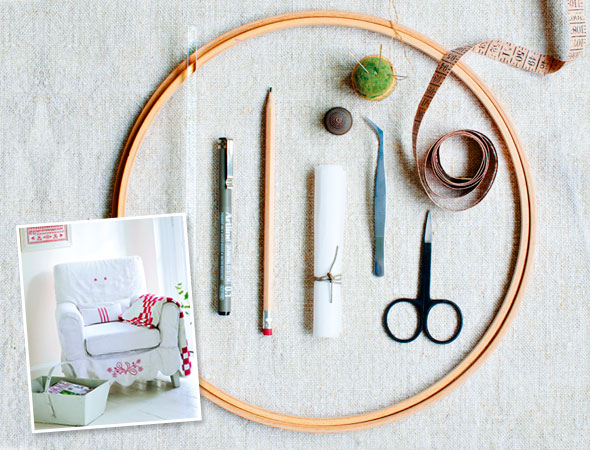Handmade home
There is still a place for embroidered detail in our homes. It can be as simple as a flower on the edge of an upholstered chair; or a sparely furnished room with a neutral colour palette can be transformed by a richly embroidered surface. And you can add this detail to your home yourself.
 Clockwise from left: a beach-house kitchen is given a pop of colour with this vintage patchwork pelmet; this table runner is fashioned from a vintage French roller towel. The flower petals are made from scraps of vintage fabric
Clockwise from left: a beach-house kitchen is given a pop of colour with this vintage patchwork pelmet; this table runner is fashioned from a vintage French roller towel. The flower petals are made from scraps of vintage fabricFor inspiration, gather anything that takes your eye: threads, buttons, scraps of lace… all can be incorporated into embroidered pieces or used as a colour palette. The more you surround yourself with beautiful colours and textures, the easier you will find it to dream up things to embroider.
In terms of materials on which to embroider, I love antique French linen sheets, but if you are buying new fabric, try to find one with a bit of life and texture to it. Many fabric houses produce lightweight linens designed to have the look and feel of old fabric. If you use new fabric, wash it at the hottest temperature recommended to pre-shrink it; there is nothing worse than washing your finished work and finding the material shrinks and your embroidery does not.
 From left: linen back rests with interesting designs bring these chairs to life; French decorative edging from the 19th century, featuring handstitched vegetables, fruit and ceramics
From left: linen back rests with interesting designs bring these chairs to life; French decorative edging from the 19th century, featuring handstitched vegetables, fruit and ceramics There are not many tools required for embroidery. Some people use an embroidery hoop, but generally I do not. There are various sizes of needles – the higher the number, the finer the needle – and a key tool is a pair of very sharp scissors with pointy tips.
But you can add embroidered detail to your home, whatever your personal decorating style may be.
 The essential tools: a hoop, craft tweezers, scissors, pencil and measuring tape. Inset: red stitching on white is called Redwork. Keep the decoration simple and subtle
The essential tools: a hoop, craft tweezers, scissors, pencil and measuring tape. Inset: red stitching on white is called Redwork. Keep the decoration simple and subtleThe Hand-Stitched Home: Projects And Inspiration For Creating Embroidered Textiles For The Home, by Caroline Zoob, is published by Jacqui Small, priced £20.



